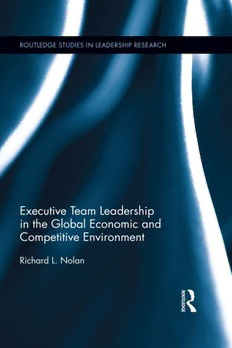
Executive Team Leadership in the Global Economic and Competitive Environment PDF
Preview Executive Team Leadership in the Global Economic and Competitive Environment
Executive Team Leadership in the Global Economic and Competitive Environment Corporations have continued to grow and extend their operations into the global economy to the point that the modern corporation has become larger and more infl uential than many sovereign countries. In this global expansion, corporations have extended their operations with little restraint—almost only limited by corporate lawyers’ imaginations. Modern corporations have become so pervasive that world populations are more dependent on them for their food, services, technologies, work, and daily well-being than ever before. This book analyzes the twenty-first-century forces challenging the execu- tive leadership of the modern corporation. Lessons are drawn for corporate leaders facing these challenges: turbulent times, balancing creators and stew- ards, managing company culture, managing by wire, incorporating global virtual organization structures, and managing sustained innovation. Nolan concludes with guidelines on creating a leadership agenda for transforming the corporation to successfully compete in the realities of the new corporate world of the twenty-first century. Richard L. Nolan is the William Barclay Harding Endowed Professor of Business Administration, Emeritus at Harvard Business School, United States. He was the fi rst recipient of the Boeing Philip M. Condit Endowed Professor of Business Administration at the Foster School of Business Administration, University of Washington in 2003, and in 2012, he became Professor Emeritus. Routledge Studies in Leadership Research 1 Executive Team Leadership in the Global Economic and Competitive Environment Richard L. Nolan Executive Team Leadership in the Global Economic and Competitive Environment Richard L. Nolan First published 2015 by Routledge 711 Third Avenue, New York, NY 10017 and by Routledge 2 Park Square, Milton Park, Abingdon, Oxon OX14 4RN Routledge is an imprint of the Taylor & Francis Group, an informa business © 2015 Taylor & Francis The right of Richard L. Nolan to be identified as author of this work has been asserted by him in accordance with sections 77 and 78 of the Copyright, Designs and Patents Act 1988. All rights reserved. No part of this book may be reprinted or reproduced or utilized in any form or by any electronic, mechanical, or other means, now known or hereafter invented, including photocopying and recording, or in any information storage or retrieval system, without permission in writing from the publishers. Trademark Notice: Product or corporate names may be trademarks or registered trademarks, and are used only for identification and explanation without intent to infringe. Library of Congress Cataloging-in-Publication Data CIP data for this book has been applied for. ISBN: 978-1-138-81387-8 (hbk) ISBN: 978-1-315-74784-2 (ebk) Typeset in Sabon by Apex CoVantage, LLC To all the many people who have generously shared their experiences and insights with me and from whom I learned so much about the exciting and important corporate journey into the twenty-fi rst century—and a special thanks to the people of the Boeing Corporation who I have had the pleasure of working with and knowing throughout my working and academic career. This page intentionally left blank Contents List of Figures and Tables ix Foreword xi Preface xiii Acknowledgments xvii 1 Turbulent Times 1 2 Then and Now 16 3 Creators and Stewards 27 4 Culture Is Everything 36 5 Managing by Wire 59 6 From Vertical to Virtual Integration 75 7 Managing Sustained Innovation 87 8 Managing Corporate Transformation 99 9 Twenty-First-Century Imperatives for Boards and Senior Executives 117 10 From Industry Commons to Global Industry Ecosystems 134 11 The Modern Corporation in the World 147 Epilogue 156 About the Author and Research 159 Index 163 This page intentionally left blank Figures and Tables FIGURES 1.1 Evolution of the Boeing Corporation 6 1.2 First U.S. International Airmail Flight 7 2.1 First Boeing Commercial Passenger Airplane and Modern Dreamliner Flying Together 24 3.1 Differences between Stewards and Creators in Corporations 29 5.1 Sixteen Boeing B-17s Manufactured within Twenty-Four Hours 64 5.2 Boeing Plant 2: “Lean Manufacturing” of B-17s 65 5.3 Boeing 737 Pulse Line 70 5.4 Boeing 737 Moving Line 72 6.1 Vertical Computer Industry Structure 1991 and IBM’s Segment Market Shares 76 6.2 The New Horizontal Computer Industry Structure 76 6.3 Boeing’s Prevailing Hierarchical Organizational Structure 78 6.4 Creative Destruction/Construction from Boeing’s Decentralized Hierarchical Organization toward an IT-Enabled Network Organization 83 8.1 Relative Profit Margins for Product Design, Manufacturing and Marketing 108 10.1 Puget Sound Region Industry Commons, 1900–1950 138 10.2 Puget Sound Region High-Tech Industry Commons, 1950–2010 139 TABLES 10.1 Revenue and Market Value of Industry-Leading Corporations 135 10.2 Patent Activity by Major Puget Sound Region Companies 140
